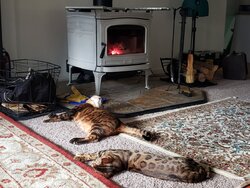Firstly, I want to say a huge 'thank you' so much to everyone on this forum, especially begreen and hogwildz whose advice I found particularly helpful when it came down to choosing between the BK and PE (and almost the Quadrafire if they hadn't quit making the Explorer). I've been lurking on and off for over maybe a decade...since I used to burn wood in an old smoke dragon that was in a townhouse I rented around 2010.
Just had a PE Alderlea T5 Classic LE in antique white installed, and have two questions I can't find answers to by searching:
1. I followed PE's "first fire' instructions closely: opening doors and windows, fire size for the 3-4 hours of use, etc....except I was loving it so much I just sort of kept having a fire for the next two days straight, and I don't think it's been completely cool since last weekend. I think I missed the part where you're supposed to have a series of small fires first. Is this something I should be concerned about?
2. Does it matter where I place my STT? I put it just left of the flue so I can keep a pot in the middle with the trivets open.
Included a pic just cuz.

Just had a PE Alderlea T5 Classic LE in antique white installed, and have two questions I can't find answers to by searching:
1. I followed PE's "first fire' instructions closely: opening doors and windows, fire size for the 3-4 hours of use, etc....except I was loving it so much I just sort of kept having a fire for the next two days straight, and I don't think it's been completely cool since last weekend. I think I missed the part where you're supposed to have a series of small fires first. Is this something I should be concerned about?
2. Does it matter where I place my STT? I put it just left of the flue so I can keep a pot in the middle with the trivets open.
Included a pic just cuz.



 When I picked my SIL's stove, it was gonna be a T5 or a Woodstock AS, High Style. In the end I went with the KISS principle.
When I picked my SIL's stove, it was gonna be a T5 or a Woodstock AS, High Style. In the end I went with the KISS principle.
